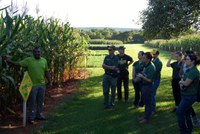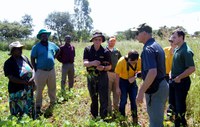Tour Gives Students Insight Into Agriculture Abroad
(Click an image below to view a high-resolution image that can be downloaded)
-

NDSU Extension specialists and Plant Sciences research specialists and students visit with a corn breeder during a study tour in Zimbabwe and Kenya. The African company that provided seed for this field uses animal images on its field signs to indicate when a particular hybrid matures. (NDSU photo) -

NDSU Extension specialists and Plant Sciences research specialists and students visit Zimbabwe's International Maize and Wheat Improvement Center during a study tour of research and Extension activities. (NDSU photo)
Like a lot of students, eight from North Dakota State University’s Plant Sciences Department took a trip during spring break.
But their trip was anything but typical.
Master of science students Tracy Hillenbrand, Melissa Geiszler, Lizzy Lovering, Matt Rellaford, Kelsie Egeland, Nick Schimek and J Stanley, and Ph.D. student Jason Adams, along with NDSU research specialists Chad Deplazes and Darin Eisinger, participated in a study tour of research and Extension activities in Kenya and Zimbabwe.
“These activities support the development of resilient agricultural practices for small-holder and commercial farmers in those countries,” says NDSU professor and Extension Service agronomist Joel Ransom. He and Hans Kandel, also an NDSU professor and Extension agronomist, led the tour.
The group toured a rose-breeding facility in Kenya that develops rose varieties for the cut-flower market in Europe. The group also visited Kenya’s Rift Valley area and Lake Naivasha, which are near the rose-breeding facility, to study geology, water resources and invasive weeds.
The first stop for the group in Zimbabwe was the International Maize (corn) and Wheat Improvement Center (CIMMYT), which is near Harare, the country’s capital. The center receives funding from various international donor organizations, including the U.S. Agency for International Development (USAID).
The CIMMYT’s main emphasis is on breeding corn that has tolerance to various leaf diseases and is adapted to African growing conditions, according to Kandel.
One of the tour highlights was a visit to a number of local subsistence farmers who evaluated newly developed corn hybrids under regional environmental conditions.
“While I was more familiar with poverty-related things from my previous travels, I enjoyed learning about and experiencing how small-holder farming is done,” Geiszler says.
Tour participants also gained new insight into the importance of agricultural research in the lives of small-scale farmers and how innovative Extension and development approaches can bring new technology to farmers in very different circumstances than those in North Dakota.
“Zimbabwe has a lot of potential for farming and agriculture, but due to the political environment and other social factors, that potential is not realized,” Adams notes.
Although the majority of Zimbabwe’s farmers plant only a few acres per family, those producers are interested in using hybrid corn seed and other improved varieties, including vegetable seed, Ransom says.
One of the main seed suppliers is the African seed company Seed Co Limited. The group visited the company’s vegetable and crop research facilities and learned about the challenges to developing appropriate varieties for the various eco zones.
In addition to numbering varieties, the seed company uses small images of a monkey, zebra, lion or elephant to indicate very early, early, medium and late-maturing hybrids, respectively.
“I was quite impressed with Seed Co’s technique for labeling their varieties with animals,” Lovering says. “That was a wonderfully ingenious way for their producers to remember what seed they needed for their fields.”
The group also visited a commercial dairy farm, banana plantation and the Africa University near Mutare in eastern Zimbabwe, and learned about the regional production practices and challenges.
This was the first time many of the students had visited a developing nation.
“Although the people may be very poor, cellphones are very important,” Hillenbrand observes. “Some people struggle to have enough food and do not use mechanized farming practices, so it was interesting to see that cellphone technology has been adapted, including the use of solar charging stations, so that even those in the remote villages were able to be connected. Mobile phones hold promise in helping to disseminate important Extension messages and in connecting farmers with markets.”
Schimek particularly noticed the production difficulties.
“One of the biggest takeaways from this experience was the challenges associated with large- and small-scale production because of the number of limiting factors that can affect yield, as well as the variability that can take place across a single acre,” he says.
“Zimbabwe was selected for the 2017 program because of the important role that agriculture plays in the country’s economy and the large proportion of the population involved in agriculture,” Kandel says.
An NDSU graduate, Itai Matukwa, was very helpful in making local arrangements for the group.
NDSU Agriculture Communication - May 5, 2017
| Source: | Joel Ransom, 701-231-7405, joel.ransom@ndsu.edu |
|---|---|
| Source: | Hans Kandel, 701-231-8135, hans.kandel@ndsu.edu |
| Editor: | Ellen Crawford, 701-231-5391, ellen.crawford@ndsu.edu |

